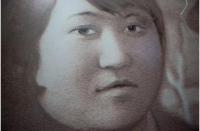The Forgotten Women Of The Gulag: A Story From Khazakhstan
Susan notes: a story of discovery by Joanna Lillis, originally published on Eurasianet (with a slide show/video); special thanks to both Lillis and Eurasianet editor Justin Burke for their kind permission to republish it on AWR.
 The women’s faces gaze down from the walls, young and old, dark and fair, blue-eyed and brown-eyed.
The women’s faces gaze down from the walls, young and old, dark and fair, blue-eyed and brown-eyed.
Some look sad, some stoical, some bitter, and some simply confused.
These women, who came from all over the Soviet Union, had one thing in common: they had been incarcerated in Stalin’s gulag although they were not even suspected of committing an offense themselves.
Their crime? Being married to an enemy of the state, for which they were sent to this prison in Soviet Kazakhstan, ending up in part of the infamous network of concentration camps which stretched across Siberia, down onto the Kazakh steppe.
 The women’s faces gaze down from the walls, young and old, dark and fair, blue-eyed and brown-eyed.
The women’s faces gaze down from the walls, young and old, dark and fair, blue-eyed and brown-eyed.Some look sad, some stoical, some bitter, and some simply confused.
These women, who came from all over the Soviet Union, had one thing in common: they had been incarcerated in Stalin’s gulag although they were not even suspected of committing an offense themselves.
Their crime? Being married to an enemy of the state, for which they were sent to this prison in Soviet Kazakhstan, ending up in part of the infamous network of concentration camps which stretched across Siberia, down onto the Kazakh steppe.
This link in a chain christened "The Gulag Archipelago" by Aleksandr
Solzhenitsyn was called Alzhir, a Russian acronym for the Akmola Camp
for the Wives of Traitors to the Motherland.
It was not only wives who served time here, but mothers, sisters and daughters, too. There were also children in Alzhir -- and not just the offspring of "enemies of the people." From its inception in 1937 to its closure after Stalin’s death in 1953, the camp witnessed 1,507 births by prisoners raped by their guards.
A museum now stands on this quiet spot just outside Astana, Kazakhstan’s capital. The entrance is marked by a striking black and silver monument, the Arch of Grief, whose conical shape represents a traditional Kazakh bridal headdress. Fragments of barbed wire and a watchtower are vivid symbols of the imprisonment.
The bunker-like museum building houses exhibits commemorating the lives of the women incarcerated here, who numbered more than 17,000 by 1939, when Stalin’s terror was at its height. Behind, rows of names are listed on marble slabs, testimony to the sheer numbers who were forced to suffer.
Many were shipped here by train, spending up to two months trundling across the Soviet Union. On a recent summer’s afternoon, an elderly lady peered into a train wagon at the museum, similar to the one in which she was deported from Siberia in the 1930s. Why was she deported?
"How should I know?" she replied. "I wasn’t even eight."
Here the women eked out a miserable existence in grim barracks. Many did not survive; their bodies were hurled into a mass grave behind the camp, now marked by a cross and a crescent moon.
Back at the museum, a statue of a gaunt woman staring pensively into the distance symbolizes the spirit of struggle and hope, a tribute to the women who endured the ordeal of incarceration due to a cruel twist of fate.
It was not only wives who served time here, but mothers, sisters and daughters, too. There were also children in Alzhir -- and not just the offspring of "enemies of the people." From its inception in 1937 to its closure after Stalin’s death in 1953, the camp witnessed 1,507 births by prisoners raped by their guards.
A museum now stands on this quiet spot just outside Astana, Kazakhstan’s capital. The entrance is marked by a striking black and silver monument, the Arch of Grief, whose conical shape represents a traditional Kazakh bridal headdress. Fragments of barbed wire and a watchtower are vivid symbols of the imprisonment.
The bunker-like museum building houses exhibits commemorating the lives of the women incarcerated here, who numbered more than 17,000 by 1939, when Stalin’s terror was at its height. Behind, rows of names are listed on marble slabs, testimony to the sheer numbers who were forced to suffer.
Many were shipped here by train, spending up to two months trundling across the Soviet Union. On a recent summer’s afternoon, an elderly lady peered into a train wagon at the museum, similar to the one in which she was deported from Siberia in the 1930s. Why was she deported?
"How should I know?" she replied. "I wasn’t even eight."
Here the women eked out a miserable existence in grim barracks. Many did not survive; their bodies were hurled into a mass grave behind the camp, now marked by a cross and a crescent moon.
Back at the museum, a statue of a gaunt woman staring pensively into the distance symbolizes the spirit of struggle and hope, a tribute to the women who endured the ordeal of incarceration due to a cruel twist of fate.